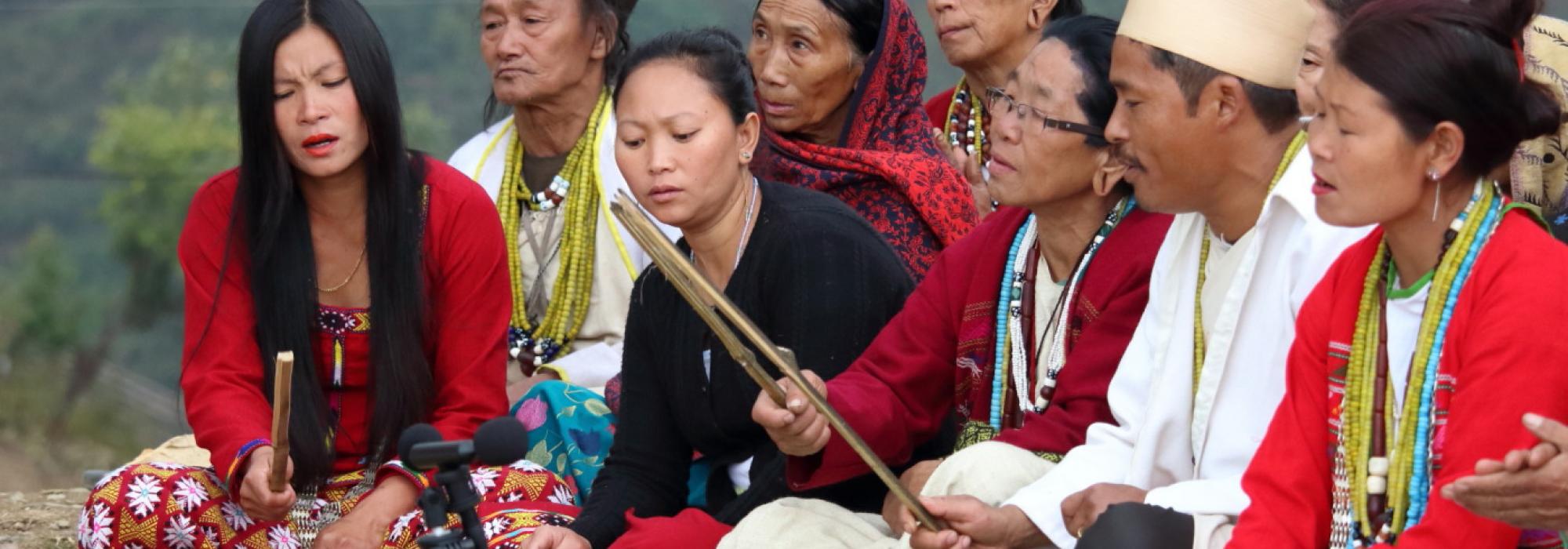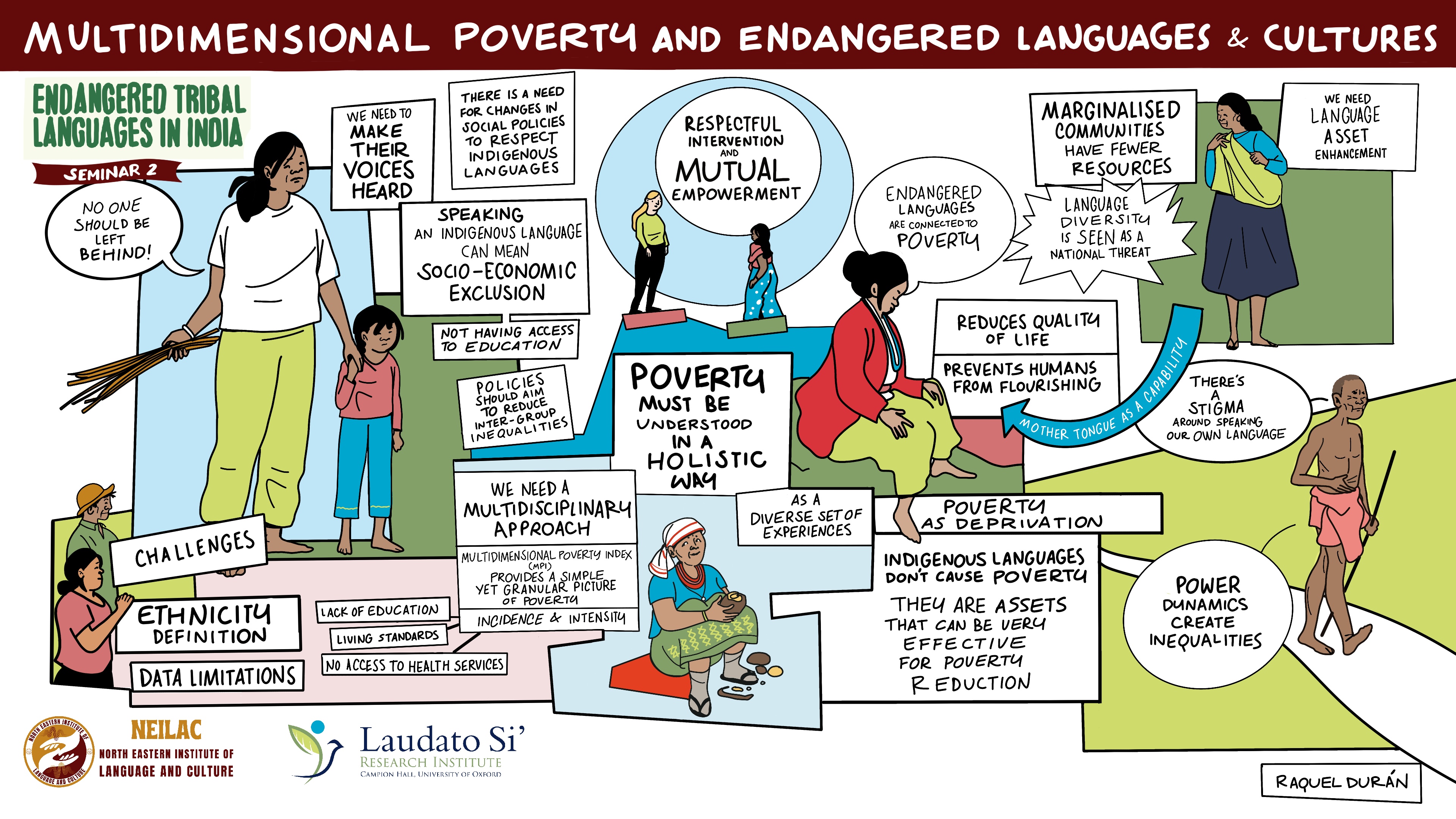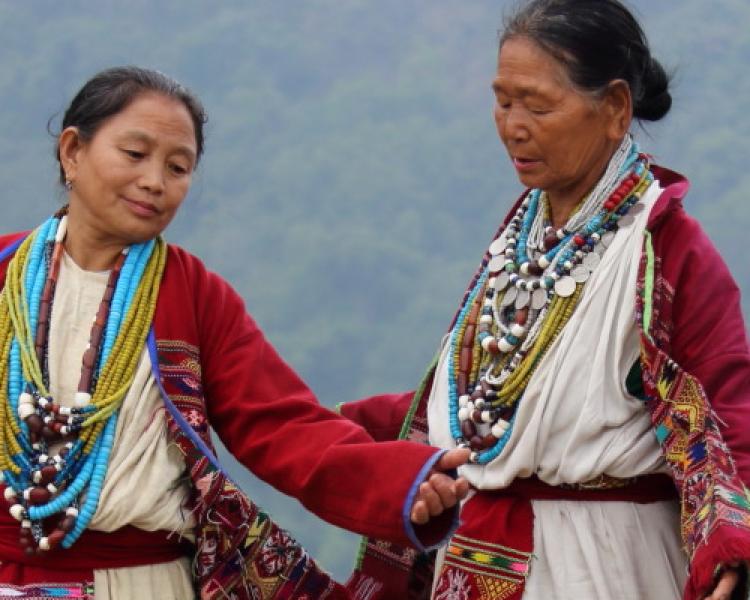
Transdisciplinary Dialogues Series: Endangered Tribal Languages in India (2)
Key Details
Seminar 2: Multidimensional poverty and endangered languages and cultures
The second seminar within the series, held in November 2022, examined the relationship between minority languages and poverty in its multiple dimensions.
What are the mechanisms through which speaking a minority language leads to political marginalisation, social exclusion, and lack of employment opportunities? How might we break these mechanisms? To what degree might the conservation of minority languages contribute to the first of the Sustainable Development Goals of ending poverty in all its forms everywhere?
Speakers:
- Dr Vijay D'Souza (NEILAC)
- Ms Fanni Kovesdi (Oxford Poverty and Human Development Initiative, University of Oxford)
- Dr Séverine Deneulin (LSRI, Campion Hall, University of Oxford), Chair
Visual Map of the Dialogue:
The seminar was a dialogue between the three speakers who have worked as academics and practitioners in different parts of the world.

Session Summary:
By way of introduction Fanni Kovesdi, who is Research Analyst at the Oxford Poverty and Human Development Initiative and lead author of the report Unmasking Disparities by Ethnicity, Caste and Gender, presented some global data of the Multidimensional Poverty Index (MPI). She argued that understanding poverty in terms of monetary poverty, while important, is incomplete because it does not accurately capture the lived experiences of poverty. She explained the methodology behind the MPI with its three dimensions (health, education and living standards), ten indicators and a list of cut-offs for each indicator. Cut-offs are a list of criteria which, if present, indicate deprivation.
She went on to present data on poverty and ethnic-based inequality. Stating that data is available for only 41 out of 108 countries where the MPI has been tracked (covering 2.4 billion people), she especially discussed the examples of Bolivia and India where the link between poverty and ethnicity has been investigated. The results showed that indigenous language speakers are comparatively worse off. In India poverty was measured by caste and the 2018 global MPI report showed that the Scheduled Tribes (STs) were the poorest. While they make up 19% of the population, 70% of the STs are MPI poor. In 2015-16, over 50% of the STs were multidimensionally poor, whereas only 20% of people outside these groups were considered MPI poor. She highlighted the challenges of measuring poverty based on ethnicity due to data scarcity and due to the problematic definition of ethnicity itself.
In the third part of her talk, she discussed Bhutan’s unique Gross National Happiness Index (GNHI) where psychological, emotional and cultural factors are included in measuring the well-being of a population. Speaking one’s native language is one of the indicators of GNHI. She commented that such criteria are worth exploring despite challenges such as measurability, objectivity and cross-cultural and transnational comparability.
Following this Vijay D’Souza, Director of the North East Institute for Language and Culture (NEILAC), brought a ground level perspective from the north east region of India. He offered a common observation that those who have given up their language seem to generally do better in terms of MPI in this region, and that indigenous languages were considered obstacles to education. He argued that it is not indigenous language speaking which is the problem, but rather oppressive models of development and poverty reduction.
Indigenous people live in extremely rich resources and yet remain multidimensionally poor because of extractive models of development. He introduced the concept of Indigenous Asset Depreciation which seeks to devalue the traditional resources of indigenous communities. In an extractive development model, such devaluation is applied to indigenous natural resources, cultures and languages. He introduced the idea that indigenous mother tongue is a ‘foundational capability matrix’. A model of education which ignores mother tongues takes away important cognitive capabilities of children and renders their education ineffective. This in turn increases poverty.
He further drew attention to the fact that everything about indigenous communities is mediated through their languages – mythology, ecological knowledge, rites, local economy, identity, oral history, worldview, festivals, and so on. Thus, language acts as a central binding force of a community’s self-knowledge and identity. So, when the central binding force is gone, all these will only remain as memories of the past. The entire worldview and ecosystems are erased. He further stated that multilingualism, built on a solid mother tongue foundation, is the way forward.
The seminar discussions examined, among other things, what can be done to influence the government in encouraging mother tongue-based education.
Vijay urged linguists to raise awareness about minority language destruction, to write in the popular media, and to think of creative ways to resist the forces of language marginalisation and cultural hegemony. Some questions were also raised about the concept of mother tongue as a ‘capability matrix’. Following Amartya Sen’s capability approach, human flourishing can happen only when a person has the freedom to express themselves to the fullest; one’s mother tongue provides that capability. One’s mother tongue lays the foundation for us to understand our connection to our communities and the world around us and becomes the matrix that holds our meaning system and identities together.




